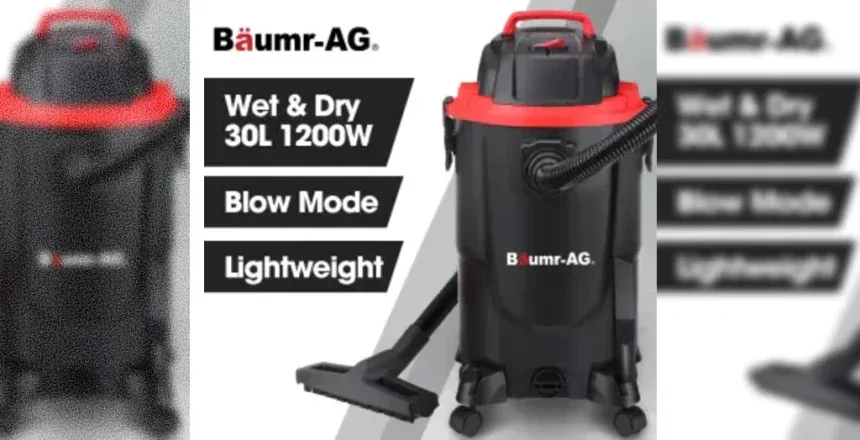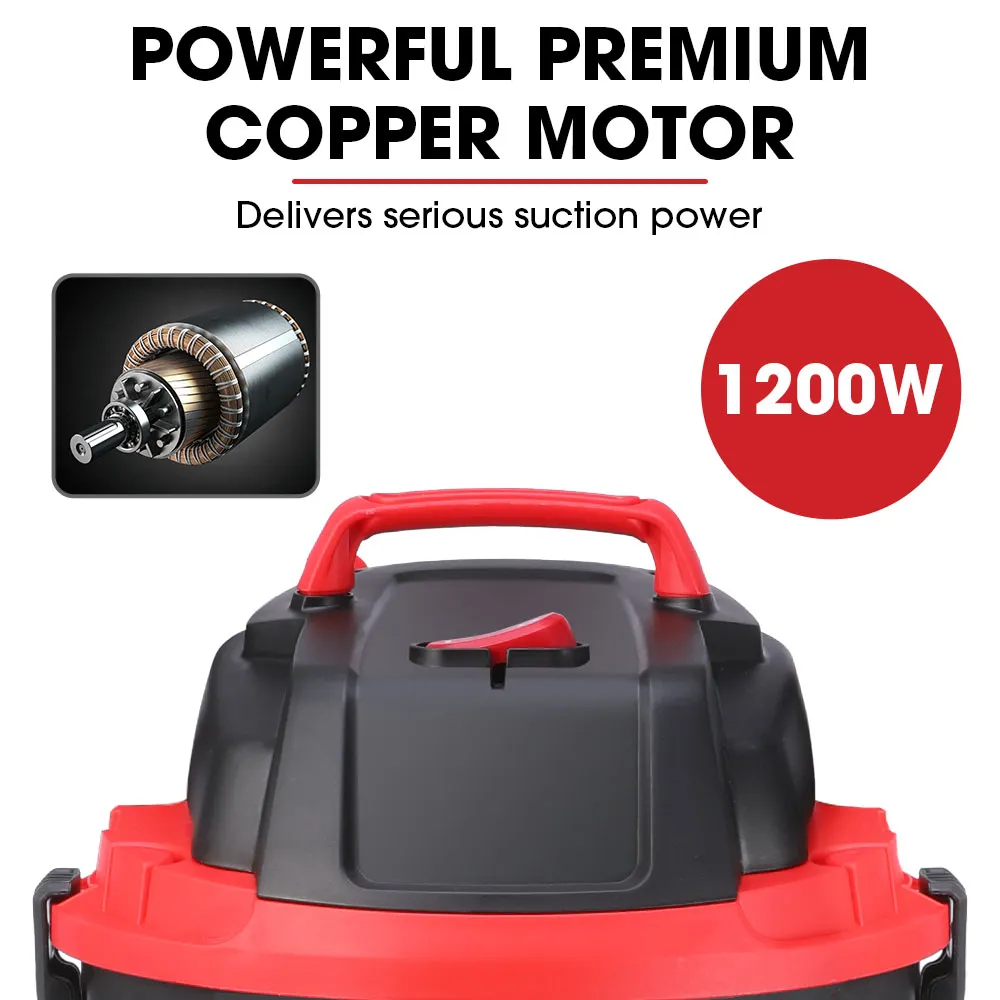The BAUMR-AG wet and dry vacuum is a 30-litre, 1200W unit with a built-in blower that suits garages, sheds, and weekend detailing. This practical guide covers performance, safety, and how it compares with popular alternatives—written for Aussie homeowners, tradies and emergency-service users.
On this page
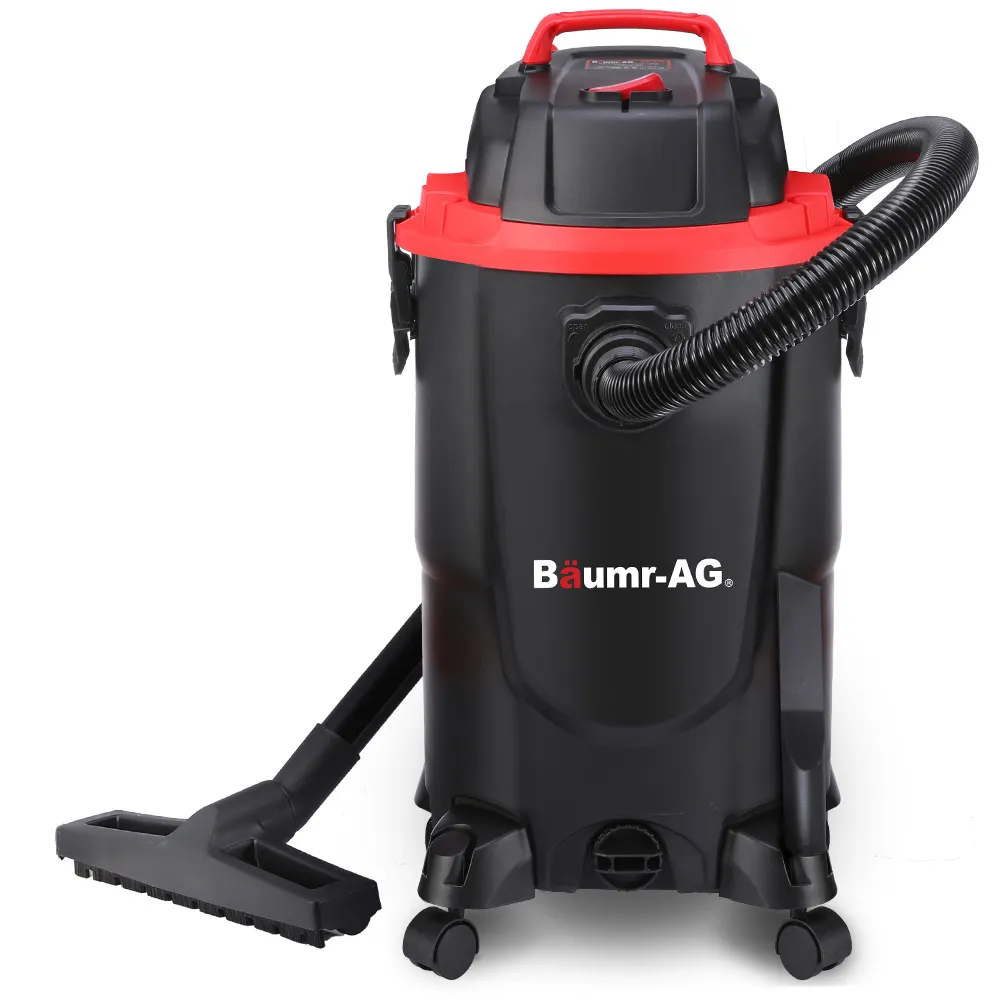
If you want one machine that handles sawdust, car grit, and accidental spills, the BAUMR-AG wet and dry vacuum is a sensible, budget-friendly option. It pairs a 1200W motor with a 30-litre stainless canister and a blower port for clearing leaves or inflating light items. It’s sized for Aussie garages and small workshops, yet portable enough for weekend jobs.
This review goes beyond specs. We explain how the system works, what it’s good at, where it struggles, and how it compares with common alternatives. You’ll also find safety notes, pro tips, and a practical buying guide tailored to local conditions and tasks.
Whether you’re a DIYer tidying reno dust, a tradie wanting fast cleanup, or a responder needing a reliable utility vac for wet areas, understanding capability and limits matters. Choosing the right filters and attachments can be the difference between a quick job and a clogged machine.
The focus here is everyday practicality: suction feel on carpet mats, stability when the drum fills, and what happens when you switch from dry debris to wet pickup. We also cover the blower’s real uses and traps to avoid.
Let’s dive in—starting with how a wet/dry unit like this BAUMR-AG moves air, protects the motor, and stays safe around liquids.
How a wet and dry vacuum works (and why it matters)
Wet/dry vacuums create negative pressure with a universal motor and fan set, drawing air and debris into a robust drum. For dry pickup, a primary filter and optional bag capture fine material before air passes the motor. For wet pickup, you must remove dust bags and fit a foam sleeve or designated wet filter so liquid bypasses paper media and doesn’t collapse it.
The BAUMR-AG’s 1200W motor is mid-range: strong enough for sawdust, screws, and car grit, without the energy draw and noise of larger contractor units. The 30L drum balances runtime between empties with portability for stairs and utes.
A rear blower port redirects airflow to push debris from corners, clear leaves from a carport, or pre-loosen dust from tight spots before vacuuming. Used smartly, it speeds up cleanup.
Key features of the BAUMR-AG wet and dry vacuum
BAUMR-AG 30L 1200W Wet & Dry Vacuum (with Blower)
- Capacity: 30L stainless drum; Motor: 1200W
- Dry filter + bag; foam sleeve for wet pickup
- Blower port for leaves, corners, pre-clean
- Caster base, carry handle, parking for wands
- Use cases: garage, vehicle detailing, workshops
Best for homeowners and light-trade tasks where portability and versatility trump raw industrial suction.
- Motor & airflow: 1200W draws well on hard floors and car mats; stable suction with a clean filter and short hoses.
- 30L drum: Fewer trips to empty with sawdust and car debris; still manageable when half-full of liquid.
- Wet pickup kit: Foam sleeve protects the motor during liquid recovery; quick-drain drum with clip latches.
- Blower mode: Clears corners, decking gaps, and leaf litter from carports; handy for pre-cleaning before vacuuming.
- Mobility: Low centre of gravity, swivel casters, and a compact footprint reduce tip risk on cords or rough floors.
- Accessories: Floor head, crevice tool and extension wands cover most home and shed needs; standard-size hoses make upgrades easy.
“`
Need a vacuum for renos or the shed?
Browse wet & dry models, filters and hoses that suit Aussie jobs.
Who benefits from the BAUMR-AG wet and dry vacuum
Home garages: Sweepings, off-cuts, and sand from weekend projects disappear quickly. The blower helps clear sawdust from awkward bench corners so the floor head can finish the job.
Car and 4WD detailing: Gritty sand in footwells, dog hair, and boot dust are well within scope. Use the crevice tool for seat rails. For fabric mats, short, slow passes keep airflow high; empty the drum sooner for consistent suction.
Workshops and sheds: Ideal for mitre-saw cleanup, router dust, and general end-of-day tidy. It won’t replace a true dust extractor at the tool port, but it’s excellent for post-cut cleanup on floors and benches.
Wet areas and emergencies: Spilled water in a laundry, defrosting a freezer, or clearing minor ingress after rain—fit the foam sleeve, remove paper bags, and proceed with short runs. Always isolate power at the point of use and keep connections dry.
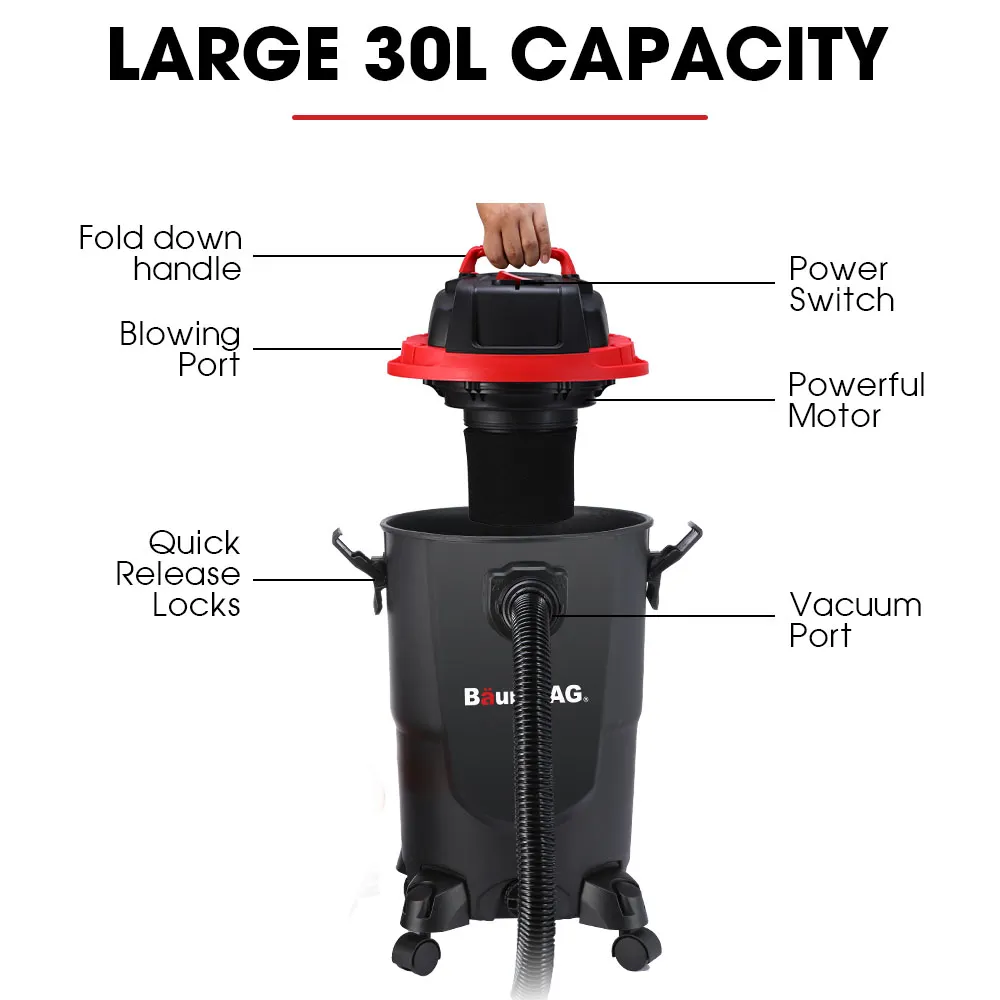
Performance, power and noise
Suction is strongest with a clean cartridge and a short hose. Expect confident pickup of screws and chips on concrete, and a steady pull on carpet mats. Noise is typical of universal-motor shop vacs; hearing protection is a smart choice for long sessions, especially indoors.
If airflow feels weak, check for a full drum, a torn or loaded bag, or a clogged cartridge. Many users overlook the tiny bleeder holes on some floor heads—closing them lifts performance on hard floors.
Filters, bags and safe wet pickup
- Dry work: Fit the cartridge filter and a bag for easy disposal and better fine-dust control.
- Wet work: Remove the bag; install the foam sleeve. Empty promptly after liquids to prevent odours and corrosion.
- Not for hazardous dust: This unit isn’t a certified M/H-class extractor. Don’t use it for silica, asbestos, or lead paint. Use the correct classed equipment and controls.
- Electrical safety: Use an RCD (safety switch) and keep the plug and extension joints off wet surfaces. Never submerge the head or motor section.
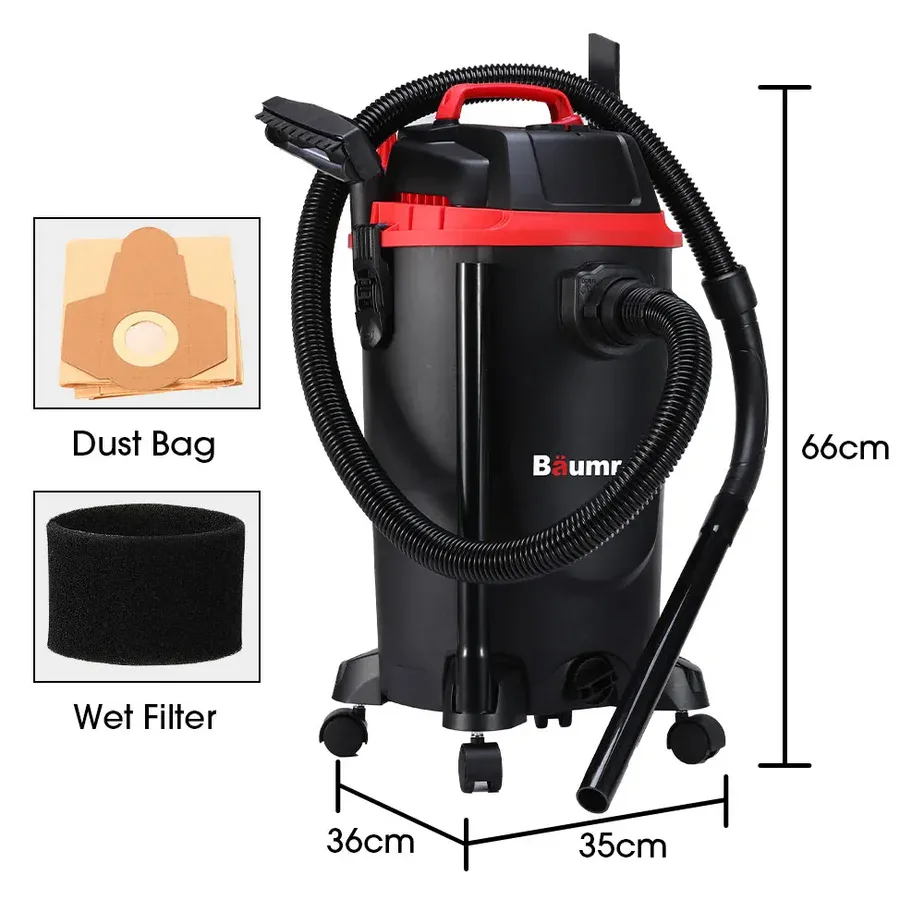
Setup, accessories and small upgrades that help
Start with the floor head for large areas, swap to the crevice tool for rails and gaps, and keep a soft brush for dashboards. If you often vacuum cars, consider a flexible detailer hose and a narrow turbo nozzle—both reduce fatigue and improve reach under seats.
For workshops, a short anti-static hose upgrade improves control around benches, while a foam wrap inside the head reduces rattles. Label your filters (dry/wet) so you don’t cross-contaminate.
How the BAUMR-AG stacks up: comparison with popular options
| Model | Motor | Capacity | Hose | Blower | Filter Type | Best For |
|---|---|---|---|---|---|---|
| BAUMR-AG Wet/Dry 30L | 1200W | 30L | Standard | Yes | Cartridge + bag; foam for wet | Garages, cars, small workshops |
| Ozito 30L (typical) | ~1250W | 30L | Standard | Yes | Cartridge + bag | Budget DIY, occasional wet pickup |
| Ryobi 30L (typical) | ~1400W | 30L | Standard | Some models | Cartridge + bag | Tool ecosystem users |
| Kärcher WD 3 (typical) | ~1000W | 17–25L | Slim | No/varies | Cartridge + bag | Compact spaces, light debris |
Tip: buy a spare cartridge and keep one dedicated to wet work (foam sleeve) and one for dry. You’ll switch tasks faster and extend filter life.
Buying guide: choosing the right wet and dry vacuum
- Capacity vs. weight: 20–30L is the sweet spot for home and light trade. Larger drums are heavy when wet.
- Motor power and airflow: Numbers help, but design matters. Short hoses and clean filters beat raw watts.
- Filter ecosystem: Look for easily available bags, cartridges, and foam sleeves. Stock up early.
- Hose/Accessory size: Standard diameters make replacement and upgrades simpler.
- Drain options: A bottom drain or quick-release latches save time after wet pickup.
- Noise and storage: Consider where it will live. A compact base with wand parking keeps clutter down.
- Safety and task class: For hazardous dust (e.g., silica), use certified M/H-class equipment with proper controls. This BAUMR-AG is for general debris and clean water only.
Pros and cons
What we like
- Balanced 30L/1200W spec for home and shed
- Blower adds versatility for quick clears
- Simple filter setup; foam sleeve for wet work
- Stable base, easy to move and store
- Good value for a stainless drum unit
Where it could improve
- Not suited to hazardous fine dust control
- Noise typical of shop vacs; consider ear protection
- Hose length may feel short in large vehicles
FAQs
Can I vacuum plaster dust? Use a bag and cartridge, clean the filter often, and work in short bursts. For silica-bearing dust from cutting, use certified M/H-class extraction instead.
Can it pick up water from a carpet? Yes, with the foam sleeve fitted. Pull moisture in overlapping passes, then ventilate and extract again after 15–20 minutes.
Will the blower inflate items? It’s fine for light inflatables and for clearing leaves. It’s not a high-pressure inflator for tyres.
What maintenance extends life? Empty promptly, dry the drum after wet jobs, and knock dust from the cartridge outdoors. Replace bags before they overfill.
Where to buy and what to bundle
When purchasing, add a spare cartridge, a pack of bags, and the foam sleeve if not included. A crevice tool and soft brush improve car results. For wet work, plan storage for the hose and wands so they dry fully between jobs.
Emergency Contacts — Australia
- 000 — Police, Fire, Ambulance
- 132 500 — SES (storm/flood assistance)
- 13 11 26 — Poisons Information Centre
- 1800 022 222 — Healthdirect
Quick maintenance tips
- Empty the drum before it’s full for steadier suction.
- Knock dust from the cartridge outdoors; replace when media thins.
- After wet jobs, rinse and dry the drum and foam sleeve.
- Inspect the cord and plug; use an RCD on extensions.
- Label filters: “DRY” vs “WET” to avoid mix-ups.
For professionals
Tag and test portable electrical equipment to your site standard (e.g., per local testing schedules). Use RCD-protected circuits and suitable IP-rated leads outdoors. For respirable crystalline silica or other hazardous dusts, deploy certified M/H-class extraction with appropriate controls and respiratory protection—this 30L BAUMR-AG is for general debris and clean water only.
Disclaimer: Always follow safety protocols and training when using equipment.


